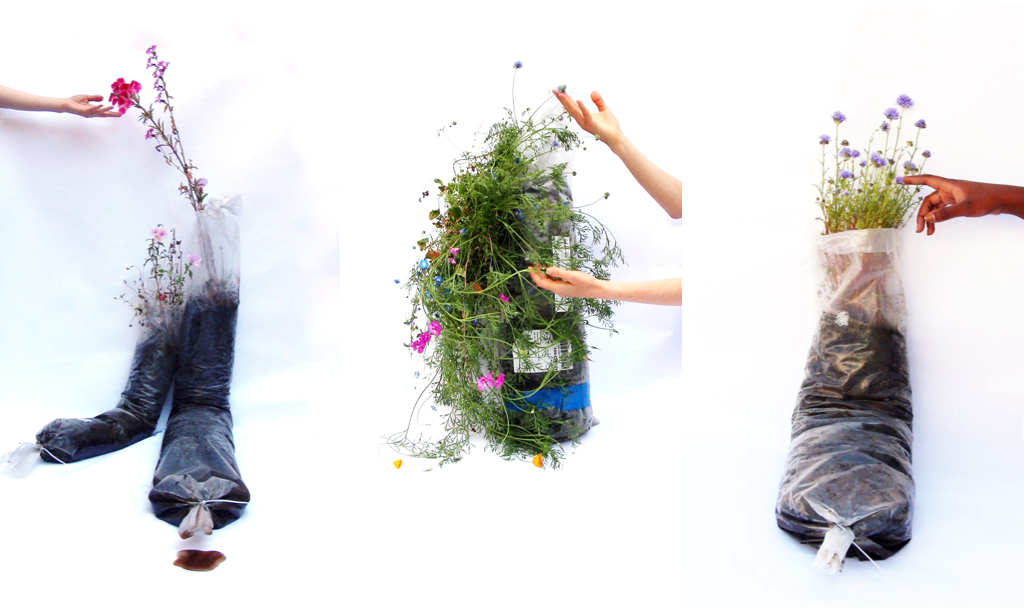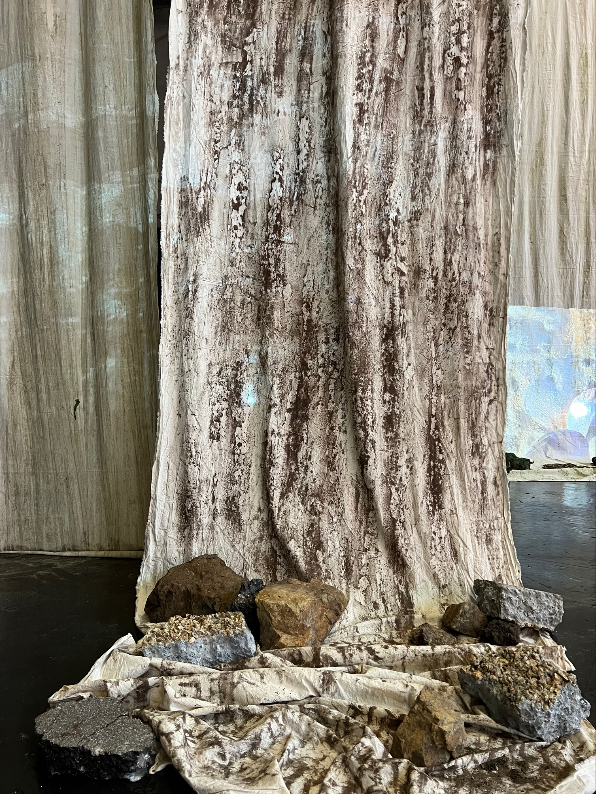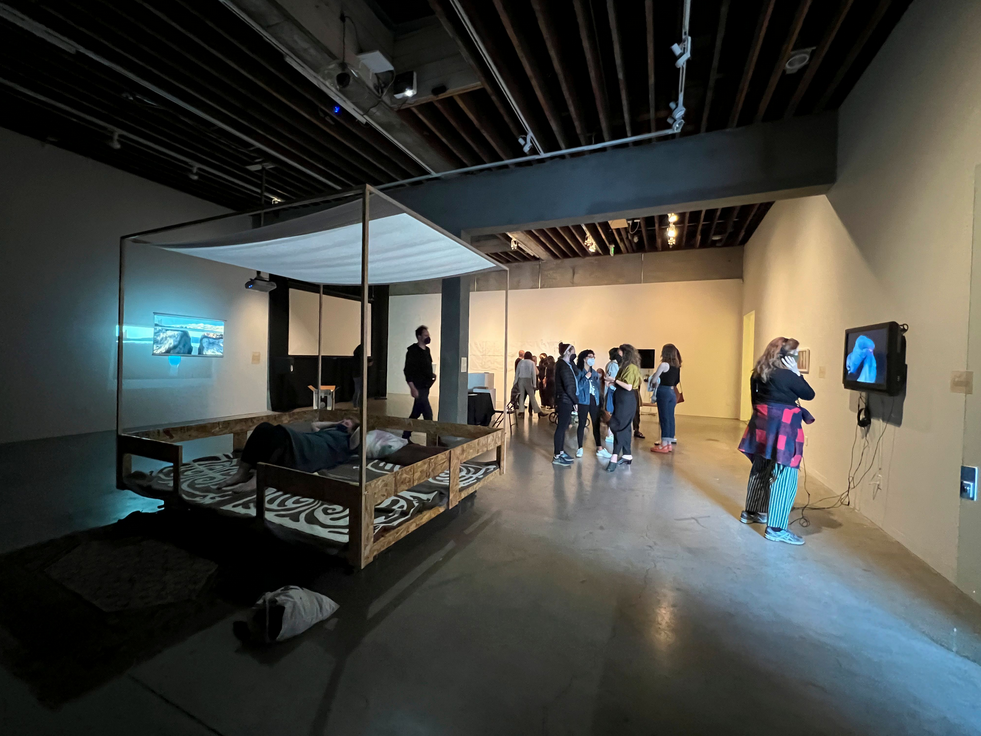
Bay Area Eco Artists: Where Art Meets Nature by Leora Lutz
This past spring has been a busy time for several ecoartspace members who live in the San Francisco Bay Area. Through intimate interactions with the land and with each other, they are making poignant and pivotal statements to help further the dialog about ecological trauma.
Alicia Escott was one of four artists selected from over 130 applicants for the Annual Artists Life Cycle juried exhibition titled “This Land: Art/Act Local," now on view at the David Brower Center in Berkeley. The prompt for the exhibition is “What does it mean to be connected to the land that holds us and life on this planet, along with the imperative to protect it?” Her work is serious and poetic, but within that dynamic is a sense of gentle levity, a light acknowledgement of the magnitude and absurdity of humans’ relationships with objects, waste and living things.
The artist's contribution to the show titled “Various Metabolic Rifts and Domestic Interiors: An ongoing series of collaborations with wildflower seeds” includes several “living sculptures,” eight videos, and photographs. Her work with seeds, compost, Oak Ecologies and Victorian Gold Rush architecture among other things “are always ways of getting back to the core issues of recognizing interconnectivity, that what the earth wants is so often what we want (that we need to stop fighting ourselves), and creating spaces to sit with the grief of living within mass extinction and climate crisis....”
Escott's sculptures are comprised of post-industrial/pre-consumer waste plastic bags that are full of dirt with flora sprouting through their “heads.” They lean against walls with a sense of personhood, slumped and drunk on life. In one video, brown water seeps from the tied end of a bag, as if it’s oozing its waste onto the floor. She acknowledges that there’s a fecal innuendo with these bags, yet, from this compost shoots beauty in delicate wild flowers and willowy grasses. The plants reach for light, and bloom when ready. They persevere.


Alongside these compact slow growing life forms are accompanying videos that document a person’s interaction with the plants. A woman’s arm is in frame, slowly touching a soft tan grassy frond; a tender green branch; or a bright pink gentle bloom. As the arm moves away, the plant bends in response, as if to return the gesture, or to beckon for more.

Escott also participated in a collaborative project with Bay Area-based Fog Fire Collective, alongside Jillian Crochet, Angela Willetts, Tanja Geis and Minoosh Zomorodinia. They presented a striking, monumental installation titled “Scrub Index” at the Palace of Fine Arts in San Francisco for this year’s Bioneers Conference in May. The work featured multiple 40 foot scrolls of muslin suspended from the ceiling. A labor of love. The muslin was weighted by jagged oceanic rocks from the immediate area, which the artists returned to their place of origin after the installation. Videos of hands kneading and “washing” the fabric were projected onto the fabric surfaces.
Created onsite in the ocean-shored areas adjacent to the Palace, the muslin was naturally dyed by rubbings of the Palace, mud rubbings of a sea wall nearby, and in the shallow areas where green algae, and soft beige and gray sand linger. The fabric absorbs the land’s colors and textures, inverting the act of washing by “dirtying” to signify different ecologies of the area. The piece is inspired by a lake in the area that was once home to the “Washerwoman’s Lagoon”—a place during the Gold Rush for people to come and collectively wash their clothes, eat lunch, and gather while the clothes dried, draped on nearby chaparral. You can see a video of their process on their Instagram site, here.


Iranian-born Minoosh Zomorodinia also recently curated an ambitious group show titled “Between Lands” at Southern Exposure in the Mission District, which includes Iranian artists from the US and Iran. The exhibition featured several video works, inviting viewers to spend quality time with each piece, watching and listening. Much of the content was generated on the other side of the world, which further illuminated the point that ecological issues are global as well as local. The works invited visitors to “consider our attachments and anxieties in relationship with land and home when there is loss caused by war, fire, displacement, or other disaster,” stated Zomorodinia.
Through cinematography, collage, performance or mapping, the artists highlight the damage and demise of the landscape at the hands of humans. There was also an afternoon of tea and snacks held outside the gallery on the busy sidewalk, made from herbs and plants that can help curb the effects of air pollution caused by wildfire smoke. The problems caused by humans that damage land, erase history, or provoke health issues commonly stem from the need for territory or the ego’s need for power—desperation to live at the expense of our precious resources.


Yet there’s also a glimmer of hope as people endure and persist, whether through song, storytelling, sharing a moment with a cup of tea…or making art like the members of ecoartspace.